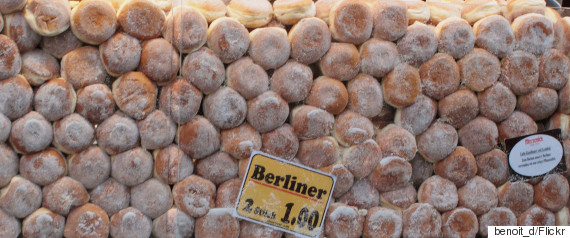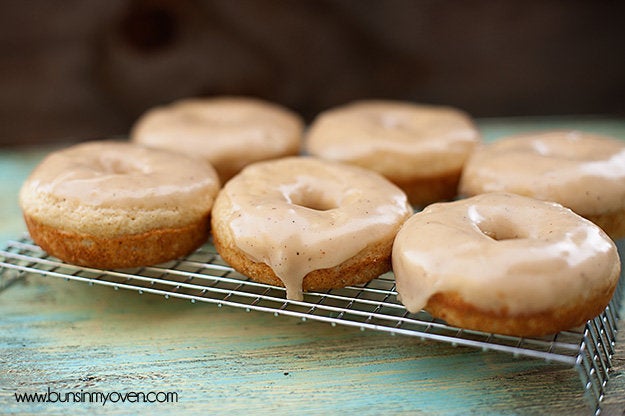"Ich bin ein Berliner." This phrase is a much-debated quotation from a June 26, 1963 speech by President John F. Kennedy in West Berlin that can either be interpreted as "I am a Berliner" or "I am a jelly donut." Though the latter would have been an unprecedented revelation, it was not the president's intended message.
There are two important things to keep in mind here:
First, Kennedy's speech occurred at the height of Cold War tensions, two years after the Berlin Wall was constructed to separate the communist East Germany from the democratic West Germany. In a bold declaration of support for the West, Kennedy passionately declared himself a Berliner in spirit by saying, "Ich bin ein Berliner." Second, a "berliner" is the term for jelly donuts in Germany.

Many contend the inclusion of the indefinite article "ein" in "Ich bin ein Berliner" implies Kennedy is a non-human "berliner," translating his phrase into "I am a jelly donut" -- but those claims are false. In reality, "ein" is necessary when speaking figuratively, which Kennedy was certainly doing -- the U.S. President was clearly not from Berlin, and was rather declaring his solidarity with its citizens. Thus he is not a donut, and he was absolutely correct.
So what exactly is a berliner? It's one of the most famous German pastries there is, with endless filling options -- think jams, chocolate and fruits. One of the greatest things about Germans is that they have so many names and styles of donuts: "pfannkuchen" in Berlin and Eastern Germany; "berliner" in the north, west and southwest; and "krapfen" in southeast Germany and in Austria. Sweet Paul Magazine features a recipe for the classic berliner in its Spring 2015 issue, which we're sharing with you here. According to Sweet Paul, the berliner was created out of sheer necessity:
One popular legend is that the berliner was founded by a sugar baker in 1756, who worked as cannoneer for Friedrich the Great, but was unable to do his work. He was permitted to stay in the fields as a baker. He created the first pancakes, then formed the dough into the typical ball, shaped like a cannonball. Because these was no oven in the field, he deep-fried them in a pan over an open fire.

Try your hand at the recipe below if you want a taste of Germany without having to leave your kitchen.
Die Klassischen Berline
The Classic Berliner
Makes 14
- 4 cups all purpose flour
- 14 grams active dry yeast
- 1/2 cup milk, lukewarm
- 1/4 cup granulated sugar
- 11 tablespoons unsalted butter, melted and cooled
- 2 whole eggs
- 2 egg yolks
- 1 pinch of salt
- 1/2 lemon, zest only
- Flour for working on the bench
- Round cutter, 3" wide
- 1 quart peanut oil, for frying
- Caster sugar, for dusting
- Piping bag with a very small decorating nozzle
- 2 cups jam, without chunks
- Dissolve the yeast in milk, take 1/2 cup of the flour, and mix it all together.
- Cover it and let it rise for about 1 hour.
- Add all the rest of the ingredients slowly adding the flour and knead to a soft and smooth yeast dough. You might have some flour left over.
- Cover the dough set in a warm place and let it rise until the size has doubled.
- Dust your working bench with flour and roll the dough about 1/2" thick.
- Cover it again with cling film and let it rest for another 15 minutes.
- With the cutter, cut as many circles out of the dough as possible.
- Transfer them very carefully onto a baking sheet with parchment paper. There has to be enough room in between the krapfen that they won't stick together.
- Put the whole sheet into a clean plastic bag and tighten it closely. They have almost to double their size.
- Meanwhile knead the leftovers together and make more krapfen out of it, but let it rest in between rolling and cutting.
- In a large wide pot, heat up the oil to about 350 degrees Fahrenheit. Be careful when putting them into the hot oil!
- Deep fry them for about 2 minutes, then flip them over for another 2-3 minutes until they are golden brown.
- Let them drain and cool down on kitchen paper.
- While still warm, put the marmalade in the piping bag and sting the nozzle into the side of the berliner right into the middle, and fill about 1 tablespoon marmalade into it.
- Dust with a sprinkling of caster sugar.
Food by Jutta Deutscher
Styling+photography by Oliver Brachat
